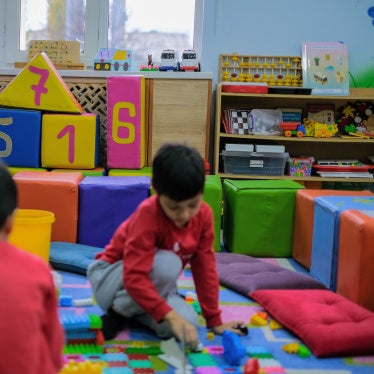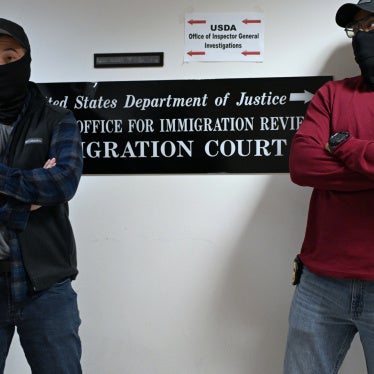The Convention on the Rights of the Child is an international treaty adopted by the United Nations on November 20, 1989, establishing global standards to ensure the protection, survival, and development of all children, without discrimination. Countries that ratify the treaty pledge to protect children from economic and sexual exploitation, violence, and other forms of abuse and to advance the rights of children to education, health care, and a decent standard of living. The convention also addresses children’s rights to a name and nationality, to be heard, to be fairly treated when accused of offenses, when deprived of parental care, and other rights.
1. How many countries have ratified the convention?
The Convention on the Rights of the Child is the most rapidly and widely ratified human rights treaty in history—with 194 countries as “states parties.” The only countries that have not ratified the treaty are Somalia, South Sudan, and the United States.
2. How has the convention improved the lives of children?
Many countries have used the convention to strengthen their national legislation and adopted new policies to improve the lives of children. Although the convention is only a contributing factor, children are better off now in many ways than 25 years ago. Greater attention to children’s right to health has meant that those born today are more than twice as likely to reach their fifth birthday than a child born 25 years ago. The obligation of countries to provide free primary education has meant that children are much more likely to attend school. In 1990, only 53 percent of children in the least developed countries were enrolled in school; today it’s 81 percent.
With greater restrictions placed on employing children, child labor rates have dropped. In the 1990s, nearly 1 in 4 children under 15 were working; today it is fewer than 1 in 8. Girls are one-third less likely to be subject to female genital mutilation than a generation ago. Now 42 countries prohibit all forms of corporal punishment against children, compared with only 4 in 1989, when the convention was adopted.
The convention is also a valuable tool for citizens and nongovernmental organizations to hold their government to clear standards in its treatment of children.
3. How are governments failing to implement the Convention?
Many children have been left out of the progress of the last 25 years. And although many countries have adopted impressive sets of laws protecting children, they often fail to enforce them. At least 58 million children are not in school—particularly girls, children from poor families, children in conflict countries, and children with disabilities. Many children suffer and die from diseases that can be easily prevented, including diarrhea and malaria. The International Labour Organization estimates that 168 million children are engaged in child labor. Every year an estimated 14 million girls around the globe—38,000 a day—are married before they turn 18.
Although the convention obligates governments to use detention as a measure of last resort and for the shortest period of time, at least one million children are detained in jails and prisons on any given day, many without charge or for non-violent or petty offenses. Tens of thousands more are detained solely because of their immigration status. Ninety percent of the world’s children live in countries where corporal punishment and other physical violence against children is still legal.
4. How is the convention enforced?
Countries that ratify the treaty must submit reports every five years to a UN committee of independent experts—the Committee on the Rights of the Child. The committee examines not only each country’s reports, but also information from nongovernmental organizations and UN sources to identify areas of progress and concern and to recommend steps that the country should take to improve the lives of children.
An optional communications procedure adopted by the UN in 2011 allows individuals to file complaints with the Committee on the Rights of the Child for violations of their rights under the convention if domestic remedies have been exhausted. The committee may then investigate the complaints and make recommendations to the country responsible for the violation.
5. Why hasn’t the United States ratified the Convention?
Of the three countries that have not ratified the convention, only the United States has not stated an intention to do so. US officials and lawmakers as well as some organizations have made various arguments against ratifying the treaty. Some assert that since US laws are already in compliance with most elements of the convention, there is no need to ratify the treaty. However, US laws and practice violate the convention in important ways. For instance, the US still allows the courts to sentence people who have committed crimes before the age of 18 to life in prison with no possibility of parole. And exemptions in US child labor laws allow children as young as 12 to be put to work in agriculture for long hours and under dangerous conditions in violation of the convention’s prohibitions on the economic exploitation of children. While the US should end these practices, they are not a barrier to ratifying the convention.
Others have contended that the convention is “anti-family” and that ratifying it would undermine the freedom of parents to raise and discipline their children. These opponents have characterized the convention as a “blank check for government intervention within the home.” In fact, the convention refers repeatedly to the rights and responsibilities of parents to raise and provide guidance for their children.
6. What are the convention’s optional protocols?
The convention has three optional protocols that were negotiated by countries after the treaty was adopted and have the status of independent treaties. The optional protocol on the participation of children in armed conflict, adopted in 2000, deals primarily with child soldiers, and sets 18 as the minimum age for direct participation in hostilities, and for any conscription or forced recruitment into armed forces. The optional protocol on the sale of children, child pornography and child prostitution was also adopted in 2000. The optional protocol on the communications procedure for filing complaints under the convention was adopted in 2011.
7. What should governments do to better fulfill the rights of children?
The rights of millions of children are still violated on a daily basis. Governments should take several key steps to fulfill their international obligations to children:
- review national legislation to ensure that it conforms with the convention— for example, by ensuring that child labor, child marriage, female genital mutilation, and all forms of violence against children are strictly prohibited;
- ensure accountability for violations of children’s rights by establishing complaint procedures and investigation mechanisms, and ensuring that abusers—whether parents, teachers, employers, police, or other officials—are fairly held responsible;
- expand practices with proven track records for increasing school enrollment and improving children’s health—for example, programs that provide direct assistance to the poorest families;
- identify marginalized and vulnerable children who are being excluded from school, health, and other services or need special protection—including girls, children with disabilities, children from ethnic and racial minorities, migrant children, and those living in conflict areas; and adopt concrete and specialized plans and policies to ensure that these children have access to schooling and other services, and are protected from the effects of armed conflict and other violence; and
- abandon policies and practices that are proven ineffective and damaging to children, including the overuse of detention and institutionalization, and make a commitment to use community- and family-based care models that are both cheaper and more effective.
8. What is Human Rights Watch doing to advance the rights of children?
Human Rights Watch has investigated violations against children in dozens of countries worldwide, published reports on our findings, and engaged with governments, the UN and other decision-makers to promote better laws, policies, and practices to improve the lives of children. For instance, in 2014 we have published reports on child labor in US tobacco fields, child soldiers fighting in the Syrian conflict, child marriage in Tanzania, and the treatment of migrant children in Indonesia. Topics on which we have worked include: child labor, children affected by armed conflict, juvenile justice, migrant children, child marriage, and the right to education.








